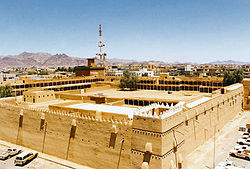Samra mountain
|
Ha'il City حائل |
||
|---|---|---|

Qishlah Palace in Ha'il
|
||
|
||
| Location of Ha'il | ||
| Coordinates: 27°31′N 41°41′E / 27.517°N 41.683°ECoordinates: 27°31′N 41°41′E / 27.517°N 41.683°E | ||
| Country |
|
|
| Province | Ha'il | |
| Government | ||
| • Governor | Saud bin Abdul Muhsin Al Saud | |
| • Deputy Governor | Prince Sa`ad bin Abdulaziz | |
| • Mayor | Ibrahim Aburas | |
| Elevation | 992 m (3,255 ft) | |
| Population (2002 census) | ||
| • Total | 412,758 | |
| Area code(s) | (+966) 016 | |
| Website | www |
|
Ha'il (Arabic: حائل Ḥā'il), also spelled Hail, Ha'yel, or Hayil, is a city in north-western Saudi Arabia. It is the capital of the Ha'il Province. The city has a population of 412,758 according to Ha'il Province.
Ha'il City is largely agricultural, with significant grain, date, and fruit production. A large percentage of the kingdom's wheat production comes from Ha'il Province, where the area to the northeast, 60 to 100 km (37 to 62 miles) away, consists of irrigated gardens. Historically Ha'il derived its wealth from being on the camel caravan route of the Hajj. Ha'il is well known by the generosity of its people in Saudi Arabia and the Arab world as it is the place where Hatim al-Tai lived. It is also the homeland of the Al Rashid family, historical rivals to the Al-Sauds.
Ha'il City was the center of the emirate of Ha'il, a clan of the Shammar tribe, from 1836 until 1921. The first emir, Abdullah bin Rashid, took power with his brother emir Obaid and Jabbr's sons. Abdullah bin Rashid continued constructing the Barzan Palace in Ha'il which had been started by Mohammad Ibn Ali. After the death of Abdullah bin Rashid (in 1847 or 1848) his son and successor, Talal (or Telal), completed the palace.
During the Al Rashid period many foreign travelers visited Ha'il and the Rashidi emirs, and described their impressions in different journals and books, including those of Georg August Wallin (1854), William Gifford Palgrave (1865), Lady Anne Blunt (1881), Charles Montagu Doughty (1888), and Gertrude Bell (1914).
...
Wikipedia


